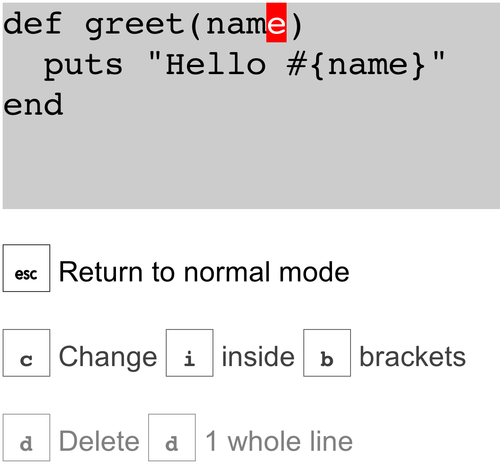Demonstrating Vim
Have you ever noticed that Vim demonstrations can sometimes feel a lot like watching a magic show? It’s very impressive, but if you want to work out how it was done you’re going to have to do some reading when you get home. If they’re not careful delivered, demonstrations that are meant to teach new users about Vim can end up contributing to the Vim learning curve myth and scaring the would-be user away.
A Vim simulator
Vim’s just not designed for demonstrations, and for a beginners talk at a Stockholm Vim meetup I needed something that looked a little less magical. The solution was to write Vimulator, a JavaScript Vim simulator that’s designed to explain each key stroke as it happens and delay the effect on the text long enough for a casual observer to see what’s going on.
Currently Vimulator supports around 40 normal mode commands including most of the basic motions, the c and d operators, a couple of text objects, and a few simple change and deletion commands (there’s a full list in the Vimulator README on GitHub).
As a command is built up, Vimulator updates the description so you always know what’s going on. Since a lot of Vim’s power comes from the ability to combine operators and motions to create sentence-like commands it’s helpful for a new user to see what each piece does as a command is constructed, and to be able to still see the context once the demonstrator’s moved on to describing the next part of the command.
Writing tests for Vim, in Vim
One of the fun things about writing a Vim simulator in Vim is acceptance testing. For each test I’d start by setting up the simulator with some useful text, and add an expectation that when no keys are pressed, nothing will change:
it("changes the word", function () {
reset("Hello world");
pressKeys("");
expect(currentText()).toBe("Hello world");
});
Then I’d modify the expected text using whichever command was under test, and record my key strokes as a Vim macro:
qq # Start recording
wcwthere<esc> # Exercise the `cw` command
q # Stop recording
Macros record to registers, so you can put the contents of a macro as if it
was some text that had been yanked. I’d drop the contents of the macro into the
pressKeys call with "qp, and swap out any special characters for a
JavaScript friendly representation:
it("changes the word", function () {
reset("Hello world");
pressKeys("wcwthere" + ESC);
expect(currentText()).toBe("Hello there");
});
Testing this way guaranteed accuracy: The expectations are generated by the target of the simulation.
Try it out
Next time you’re explaining Vim to a colleague, give Vimulator a try, or if you’ve been put off before by introductions that felt like a magic show we’ve got some posts and videos to help you learn vim.

